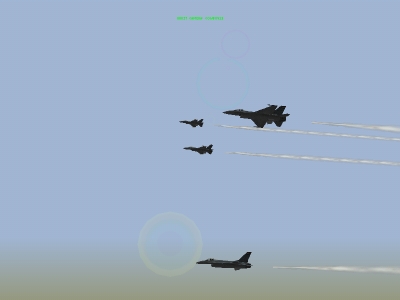

IP Cadet
|
|
|
|
|
|
|
|
|
|
|
Spread:
Moves the flight into a the formation shown below. This
formation is excellent for penetrating a highthreat area
because the flight goes throught the threat envelop
simultaneously, which forces the bad guys to pick a single
target.

Arrowhead:
Moves the flight into the formation shown below. The
arrowhead has a good and a bad side to it. The good
part is that the element can clear the 6 o' clocks of the
flight leader and his wingmen, But the bad part is the
element doesn't have anyone to clear their 6 o' clocks,
so there are very vonerable while in this formation. This
formation is good for both air-to-air and air-to-ground
missions at all altitudes
Box:
Moves the flight into the formation shown below. The box
formation is good for low altitude ingress. The box formation is
easy to maneuver and provides great 6 o' clock coverage for the
flight. In addition, the training element can easily provide
support to the lead element if the lead element is engaged.
box is also a good air-to-ground attack formation since there is
built-in spacing between elements.
Wedge:
Moves the flight into the formation shown below. Use the
wedge
formation when you anticipate a lot of high G
maneuvering.
This formation will keep the flight members from
coming into conflict with each other. The wedge formation is
very good for air-to-air attacks when you are planning to
split up a four-ship flight. This is not a good high-altitude
formation for shooting radar missiles, because the
Res
Cell: Moves the flight into the formation shown below. This
formation hides the number of aircraft in your formation
while you are in a air-to-air flight. It is useful when you are
about 20 mile or more from enemy fighters. You should not
be in res cell when you enter a turning flight because too
many jets are packed together.
Trail:
Moves the fight into the formation shown below. The trail
Formation is used exclusively for air-to-ground attack. The
problem with this formation is that in a air-to-ground situation the
element is not being supported by any other jet in the formation.
The element is, therefore very vulnerable to enemy fighters.
Ladder:
Moves the flight into the formation shown below. The ladder
formation is very similar to the trail formation in its application.
This formation should be used primarily to attack ground
targets. By having all of the flight members come in at
different altitudes, you complicate thing for the defenses.
Stack:
Moves the flight into the formation shown below. A stack
formation makes it difficult for enemy fighters to sort and
attack your formation. The disadvantage of this formation is that
it is very difficult to maneuver. It is also hard for fighters in a
stack formation to provide mutual support to each other
because of the altitude difference.